The 2022 Milky Way photographer of the year
Photographing the Milky Way is a magical experience.
There aren’t many events as moving as seeing our galaxy rising and illuminating the night sky. However, at night, many things are invisible to the naked eye. When you use a camera to capture the Milky Way, a whole new world of details, colors, and light opens up.
Beyond the technical aspects, every Milky Way photograph has a story and a seed that has been growing in the photographer’s mind for some time until all the elements align to create the image.
To help you find inspiration for planning and executing your Milky Way images, we’ve gathered the best Milky Way images taken around the world, as we do every year. Buckle up because this trip is going to take you from the remote deserts of Xingjian, Atacama, and Utah to the unfamiliar landscapes of Tibet, Australia, and New Zealand, passing by spectacular glaciers, volcanoes, mountains, beaches…always with the Milky Way shining in the sky.
“Ice Age” – Alvin Wu
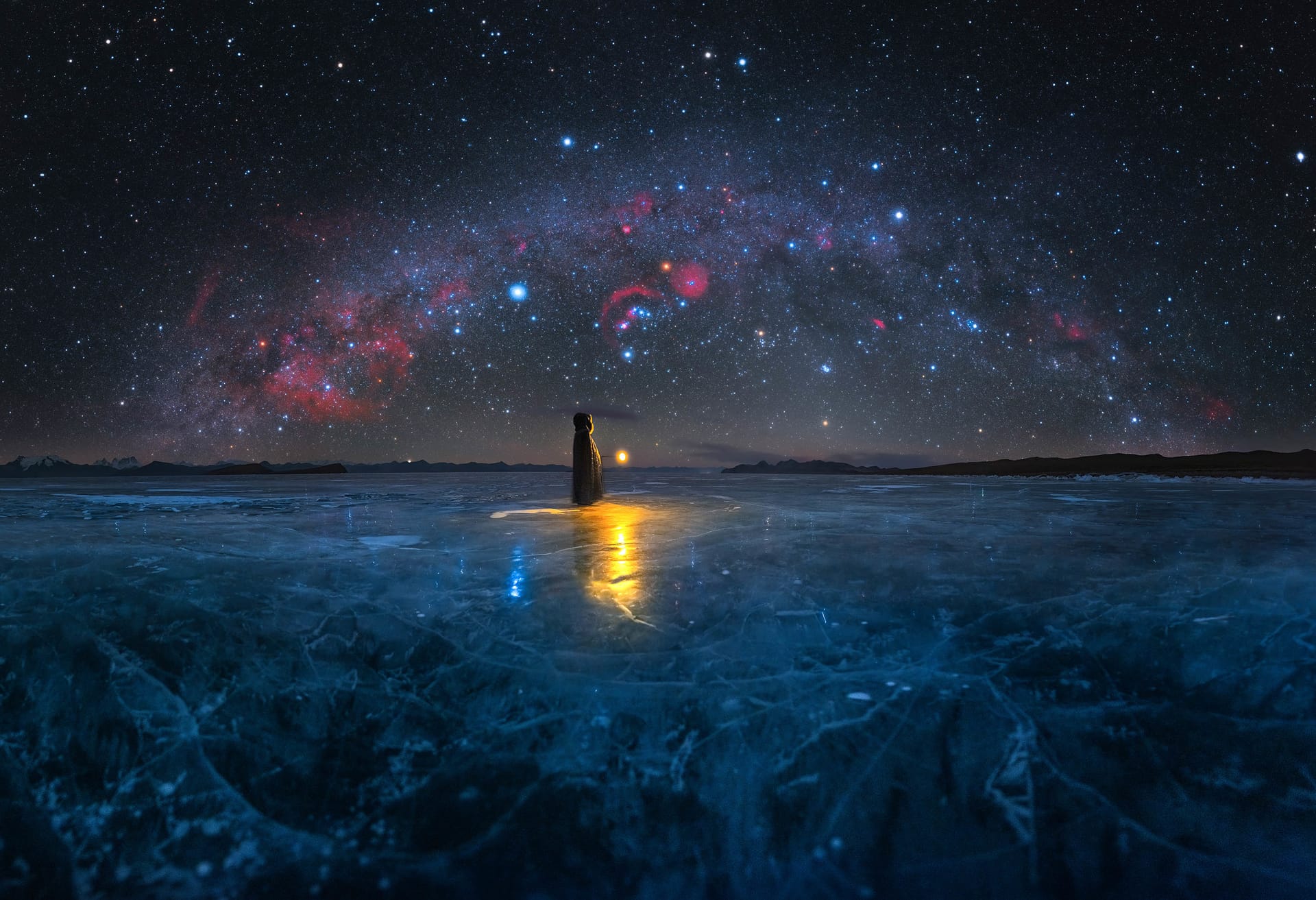
“Ice Age” – Alvin Wu
- Tibet, China
This is the Chinese version of the blue ice lake, Pumoungcuo, at an altitude of 5.070 meters (16,600 feet).
This lake, located in Tibet, freezes every winter. At night, under the low temperatures of minus 20 °C (-4 °F), you can listen to the sound of the ice cracking while capturing the most beautiful winter sky. The blue ice surface and dazzling Orion constellation create a fantasy landscape.
I felt so happy to have the stars as my companion on this magical night.
Foreground: ISO 800, f/2.8, 60 sec. (Silhouette shot separately)
Sky: ISO 800, f/1.4, 60 sec. (Shot with an equatorial mount)
“Solitude” – Nick Faulkner
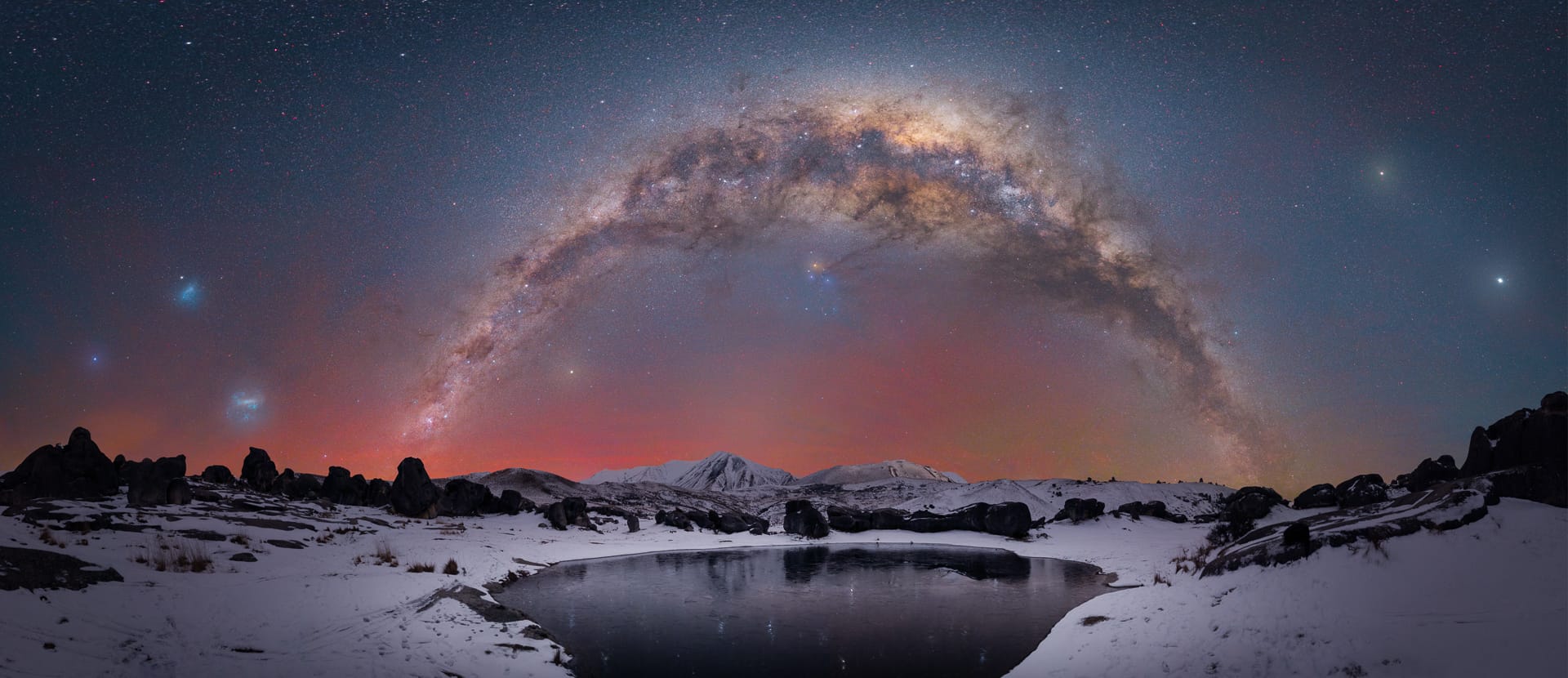
“Solitude” – Nick Faulkner
- Castle Hill, New Zealand
The epitome of an astrophotographer in New Zealand is racing off in the dead of night, mid-winter, after hearing about some snowfall in a close alpine area.
Layering up, grabbing your gear, grabbing a coffee and heading off into the mountains. After driving the back roads and going through many country towns, which have about 10 houses and a pub, and passing thousands of sheep, you arrive at a beautiful, dark, Bortle 1 sky at Castle Hill, which is situated in the heart of North Canterbury, New Zealand.
This Alpine region is one of my favourite places to photograph the stars, as it is to so many other passionate dark sky enthusiasts. The formations of hundreds of giant weathered limestone tors that erupt from mother earth, make for incredible subjects to capture. Add a late winter snow fall to that and it doesn’t get much better.
Foreground: ISO 2000, f2.8, 110 secs (16x vertical shots)
Sky: ISO 2000, f2.8, 110 secs (16x vertical shots, Tracked).
“Lightning the Milky way” – Jinyi He
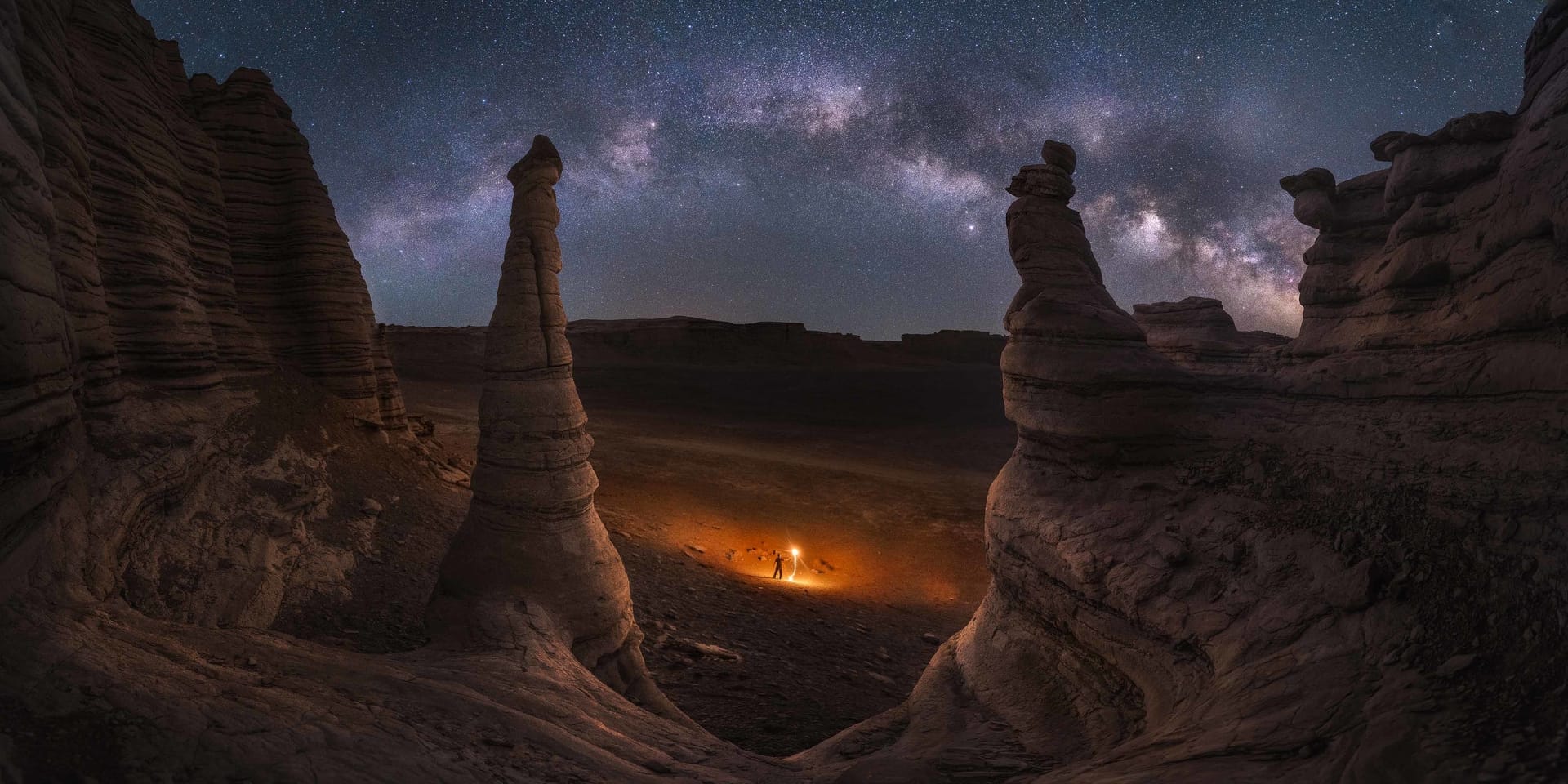
“Lightning the Milky way” – Jinyi He
- Xinjiang, China
This photo was taken in Dahaidao Desert, the no-man’s-land in Xinjiang. Because of the often fierce wind, this area gradually eroded into separate hills that take on the unique shape of a yardang.
I found this location online after lots of research and drove there in a land Cruiser with GPS.
14mm, ISO 5000, f/1.8, 20 sec. (Panorama of 4 stitched images)
“Winter Dreams” – Rubén Vela
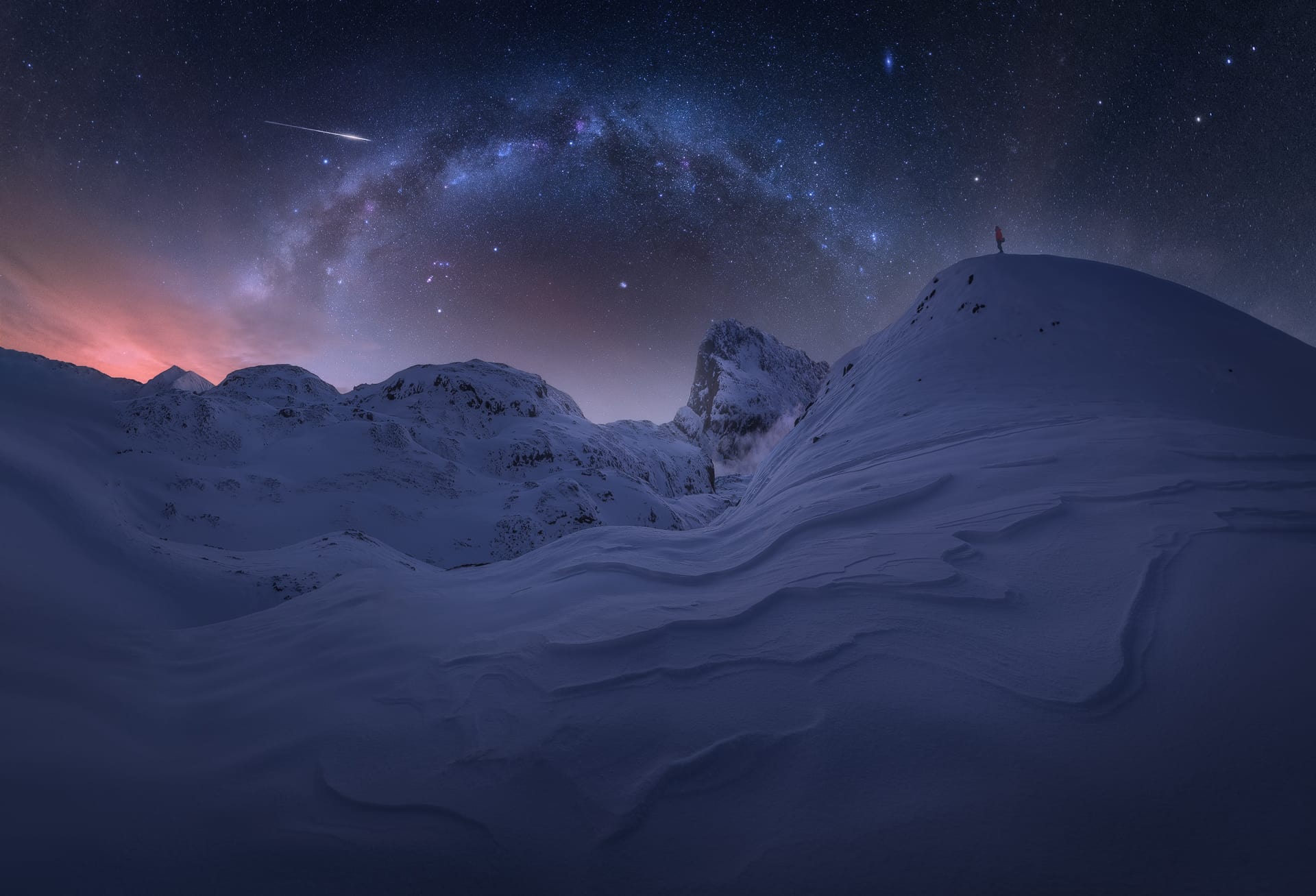
“Winter dreams” – Rubén Vela
- Picos de Europa, Spain
Winter Milky Way in the mountains of Picos de Europa, in Northern Spain. After a heavy snowfall, I was able to enjoy an incredible night of photography in complete solitude.
The conditions were tricky. To get to the location, I first made tracks without my backpack, as even with snowshoes, I was sinking in knee-deep snow. Once you get there, everything makes sense: the winter Milky Way, the mountains, the snow, the solitude… And as a gift, a shooting star crossed my lens while I was capturing this panoramic view. The shapes of the snow, the mountains, and the winter Milky Way created a magical scene that will be difficult to forget.
Foreground: 11 photos at 14mm, ISO 100, f/7.1, 1/20 sec. (Blue hour)
Sky: 11 photos at 14mm, ISO 6400, f/2.8, 25 sec.
- Nikon D610
- Nikon 14-24mm f/2.8
- Benro tripod
“Starlit Needle” – Spencer Welling
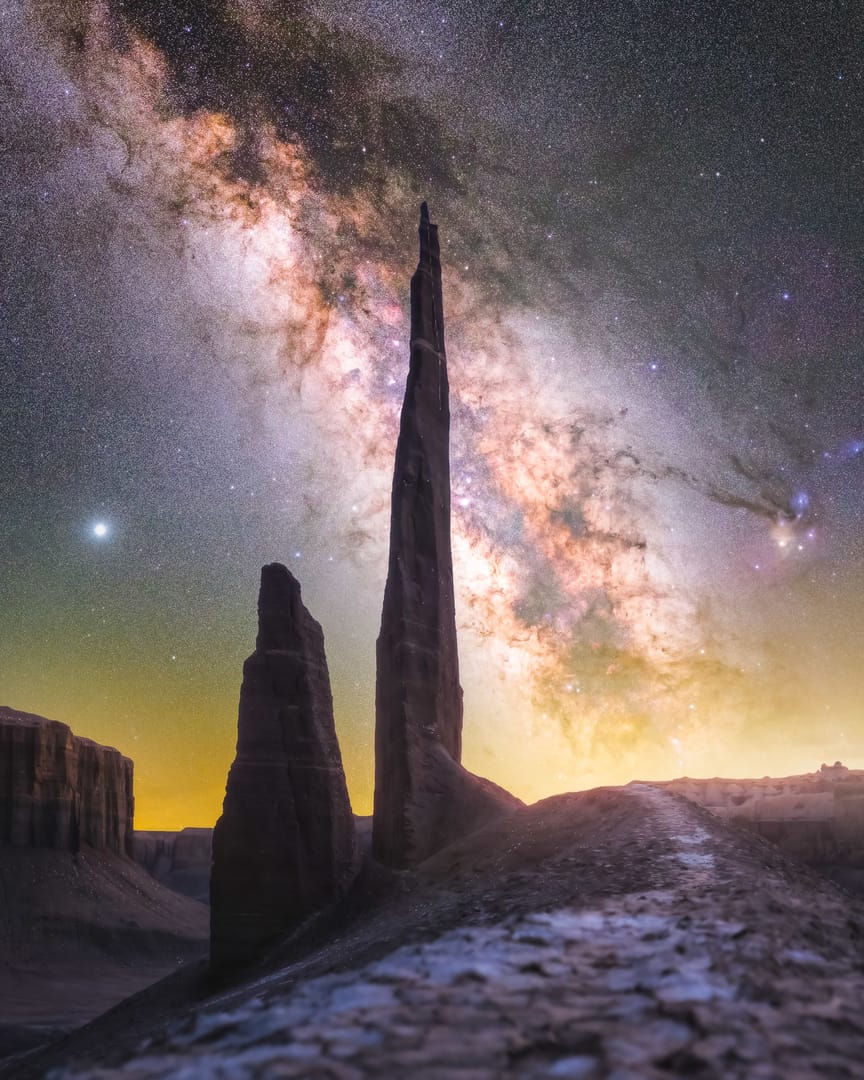
“Starlit Needle” – Spencer Welling
- Utah, USA
The badlands of Utah are brimming with stunning, unearthly landforms, hidden in the seldom seen corners of the desert.
This needle-like pinnacle is one such location nestled below a set of blue shale cliffs in the Hanksville Badlands. The night sky over this region offers some of the darkest, clearest views of the stars in the entire Southwest. On clear, moonless nights, the stars shine bright enough to cast perceptible shadows on the ground, as they did on this night when I was standing below the Needle.
Foreground: ISO 1600, f/8, 20 sec. (nautical twilight, 40 minutes after sunset)
Sky: ISO 800, f/2.8, 240 sec. (12 tracked subs)
“The Rocks” – Rachel Roberts
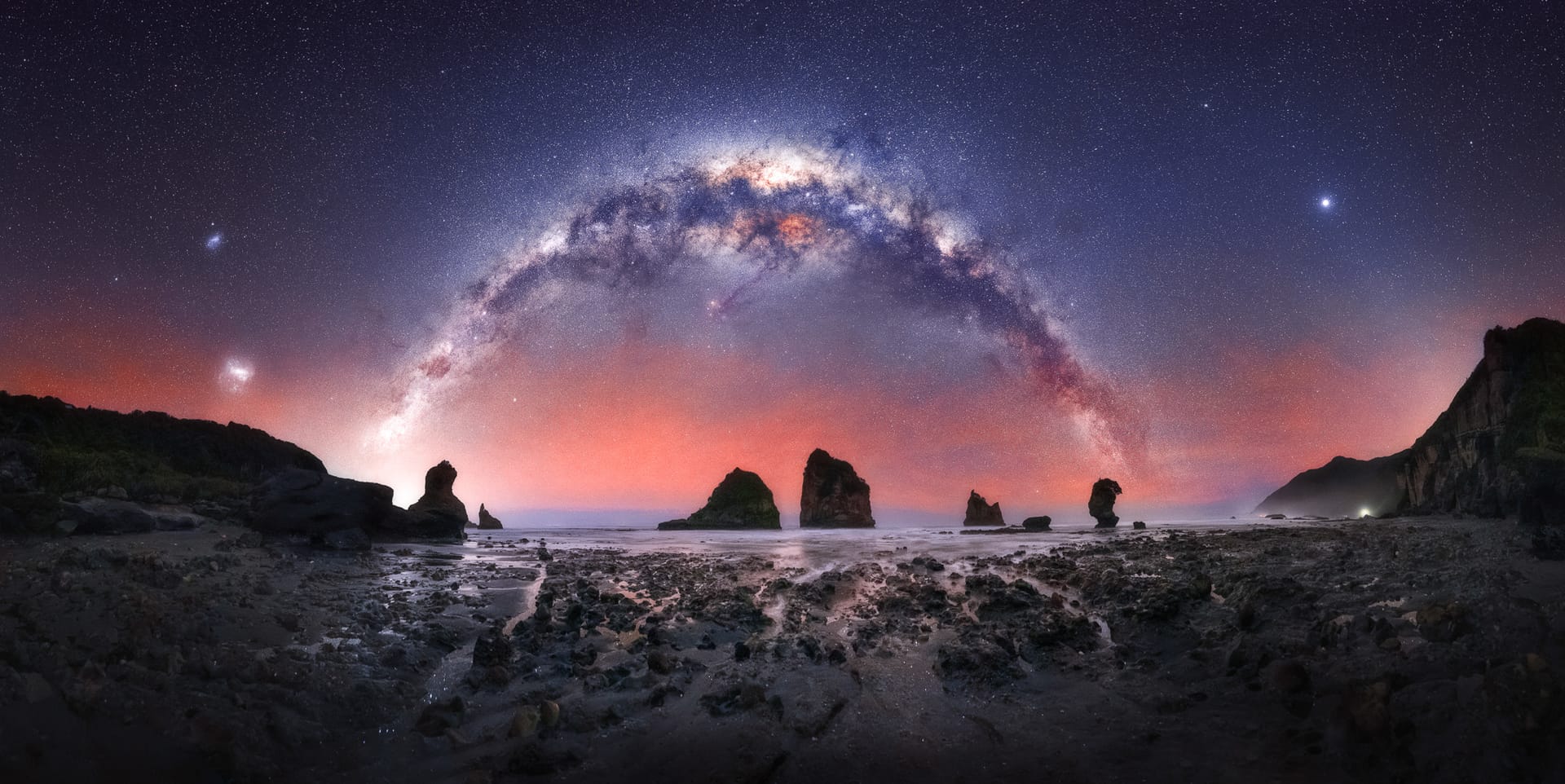
“The Rocks” – Rachel Roberts
- Motukiekie, West Coast – New Zealand
Some of the darkest and most underrated skies in New Zealand are along the West Coast of the South Island, a place I am so fortunate to call home.
Motukiekie, situated along The Great Coast Road, is a truly unique area where our southern Milky Way’s galactic core sets over the ancient sea stacks and exposed reefs.
While not the composition I was hoping to shoot this night, due to a big swell hindering any chance of getting out onto the main reef, I’m still incredible happy with what I came away with and really quite proud of the fact I was out shooting at all, as I had just had a baby 6 weeks earlier. The sleep deprivation I was feeling was next level!
ISO 12800, f/2.8, 20 sec. (Panorama of 40 images)
“Nookampa Reflections” – Will Godward
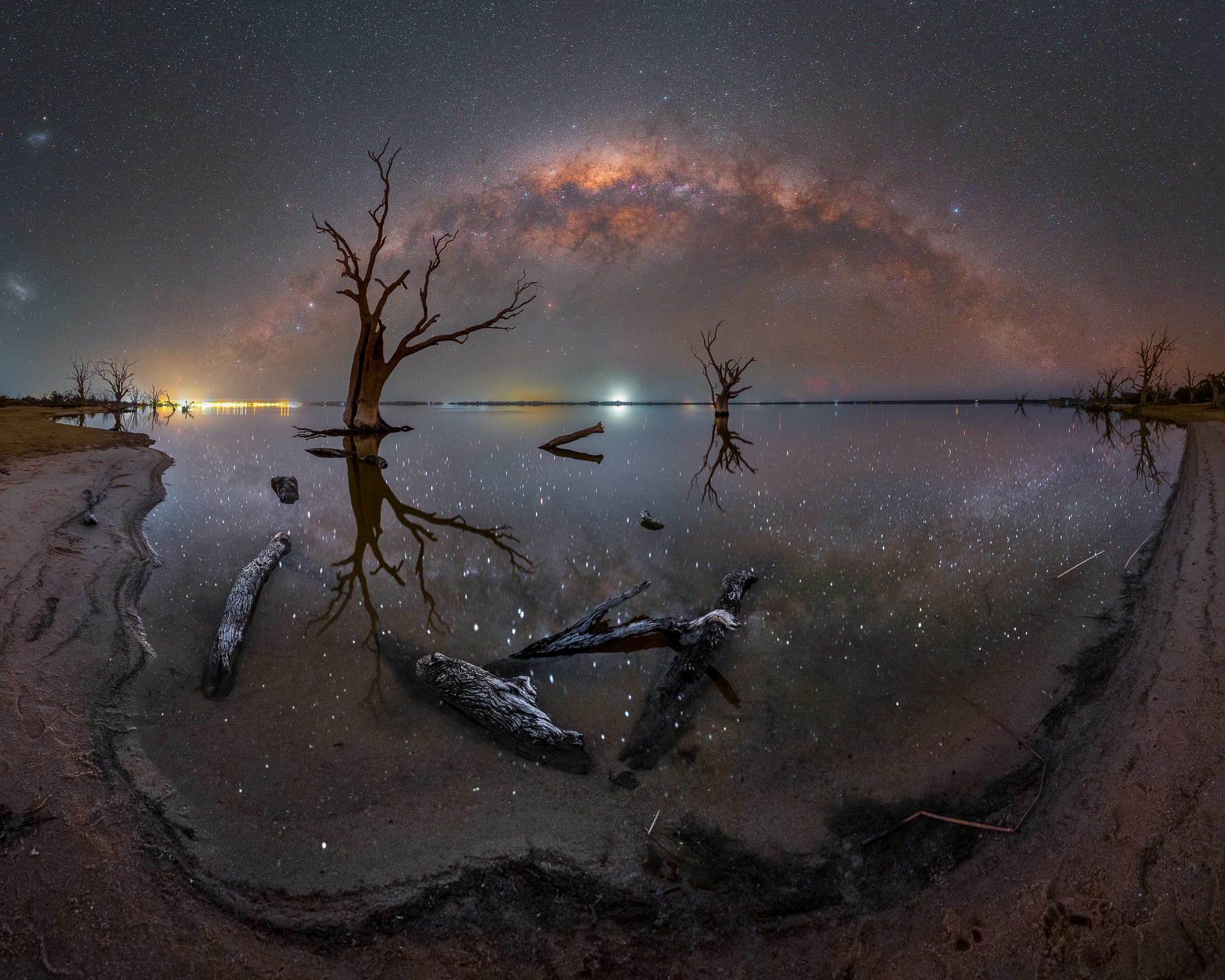
“Nookampa Reflections” – Will Godward
- Lake Bonney, South Australia
The Milky Way Galaxy stretching over the famous Lake Bonney, South Australia. Also known by its aboriginal name of Nookampa.
I’ve been wanting to capture the Milky Way Arch setting over Lake Bonney for a long time and have finally been able to cross off that bucket list shot. The perfect night and conditions made this possible. I did the wise thing and pre-scouted the location during the day. This made it so much easier to head back to the same spot after midnight. Lake Bonney is home to some of the darkest skies in the world. This image has amazing reflections of the stars in the still waters and I love how the Milky Way can be seen. The dead trees of the past create so much depth in the image.
Foreground: ISO 3200, f/2.0, 30 sec.
Sky: 14mm, ISO 3200, f/3.2, 60 sec (30 image panorama, Tracked).
- Sony A7III Astromodified
- Sony FE 14mm f/1.8
“A balcony to the stars” – Efrén Yanes
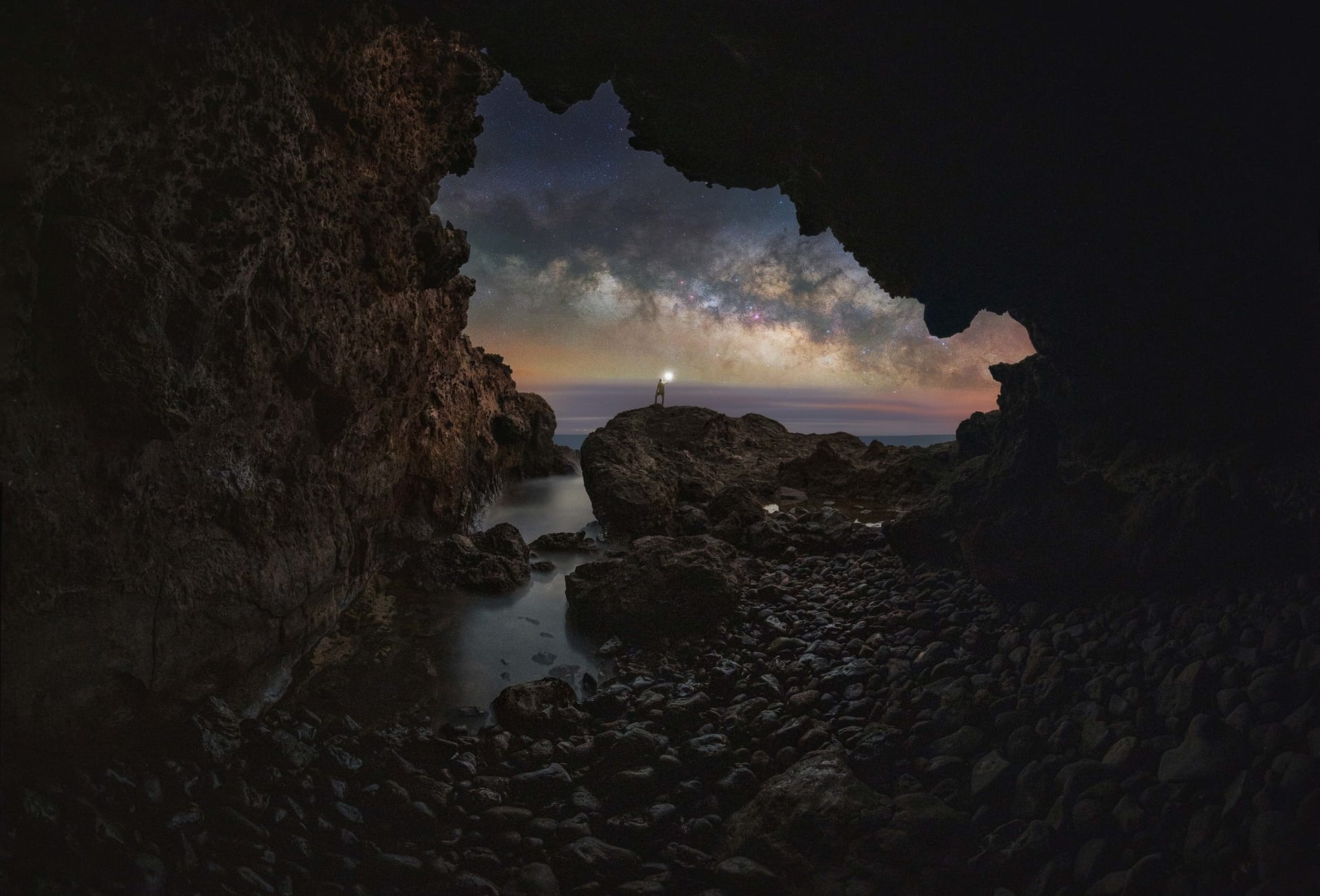
“A balcony to the stars” – Efrén Yanes
- Tenerife, Spain
Tenerife, in the Spanish Canary Islands, has many coastal caves.
I had been planning to take this photo for a long time. The first step was to plan the visibility of the Milky Way and see if it was possible to see the galactic center from inside the cave. I had made two attempts, but both were unsuccessful since, in order to enter the cave, the tide must be low, and the sea’s conditions must be perfect.
Finally, all conditions aligned and I was able to take the photo, adding myself as a human figure to give some sense of scale. I got lucky, since this is one of the few coastal places on Tenerife where light pollution hardly exists.
Foreground: Five-row panorama at 15mm, ISO 1250, f/2.8, 150 sec.
Sky: 20mm, ISO 1600, f/2.8, 120 sec.
Silhouette: 15mm, ISO 6400, f/2.8, 30 sec.
“Secret” – Marcin Zajac
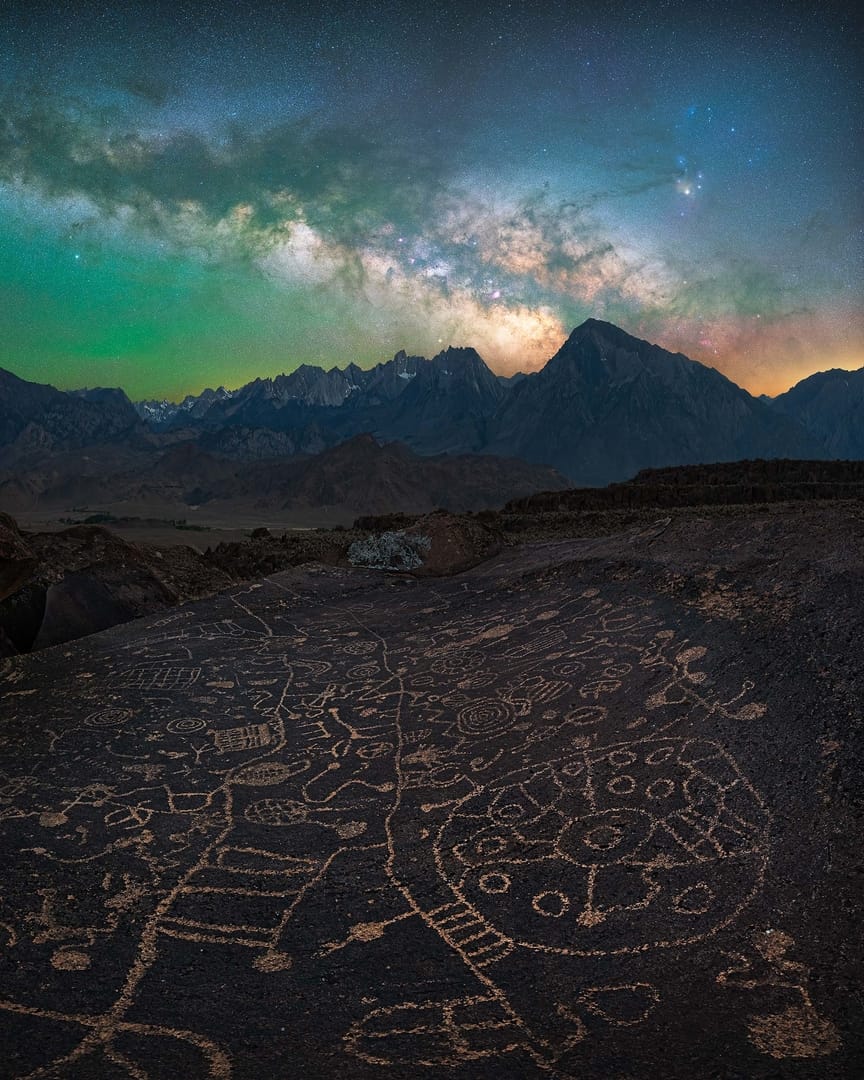
“Secret” – Marcin Zajac
- California, USA
These petroglyphs were carved into a large volcanic boulder by Native Americans who inhabited this part of Eastern California thousands of years ago. By chipping away at the dark surface of the rock, they exposed the lighter rock underneath.
What’s unusual about this panel is that it faces upward towards the sky, enabling some interesting compositions that include the California Sierra Nevada mountains and the night sky in the same frame.
Foreground: ISO 100, f/11, 30 sec.
Sky: ISO 800, f/2, 2 min.
“Winter sky over the mountains” – Tomáš Slovinský
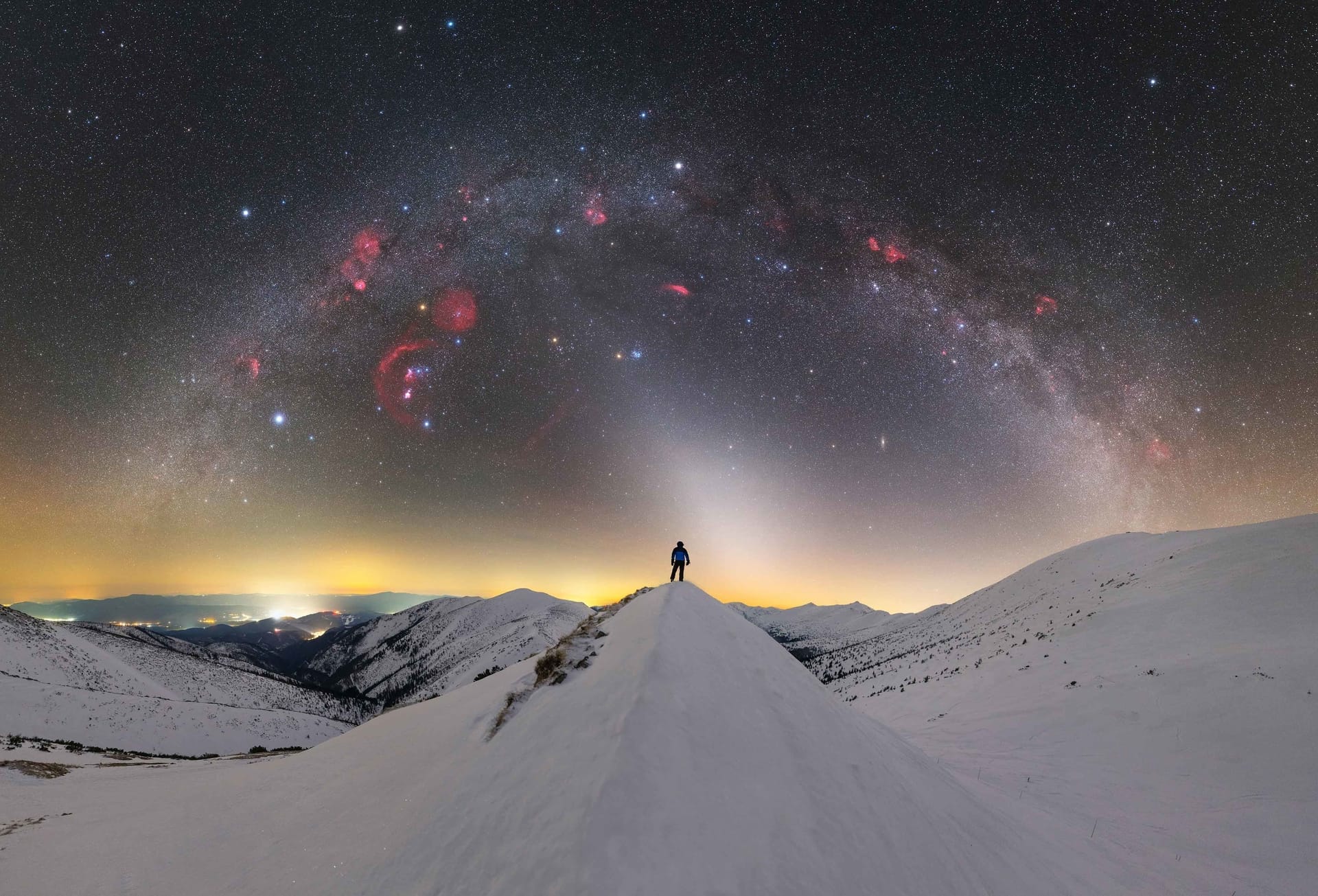
“Winter sky over the mountains” – Tomáš Slovinský
- Low Tatras, Slovakia
Although the winter portion of the Milky Way is much weaker than the summer portion, it’s still full of beautiful features that also deserve attention. This part of the Galaxy contains many bright stars, particularly those of the Winter Hexagon asterism.
Galactic arms are full of hydrogen-alpha nebulae: objects that are (almost always) invisible to the naked eye, but totally visible with an astro-modified camera. To capture more details of the H-alpha emission, I also used a special Hα filter.
The arc of our Galaxy is stretching above the Low Tatras mountains in Slovakia, where the temperatures dropped below -14°C that night. Over the subject (me), there’s a bright cone of zodiacal light pointing to a nice conjunction at the time: the Red Planet, Mars, just between two open star clusters, the Pleiades and Hyades.
Tracked Hα+RGB Pano. For nebula’s details, used Astronomik H-alpha 12nm filter.
ISO 6.400, 25″, f/2.2
For Hα 120″
“The Milky Way arching over The Pinnacles Desert” – Trevor Dobson
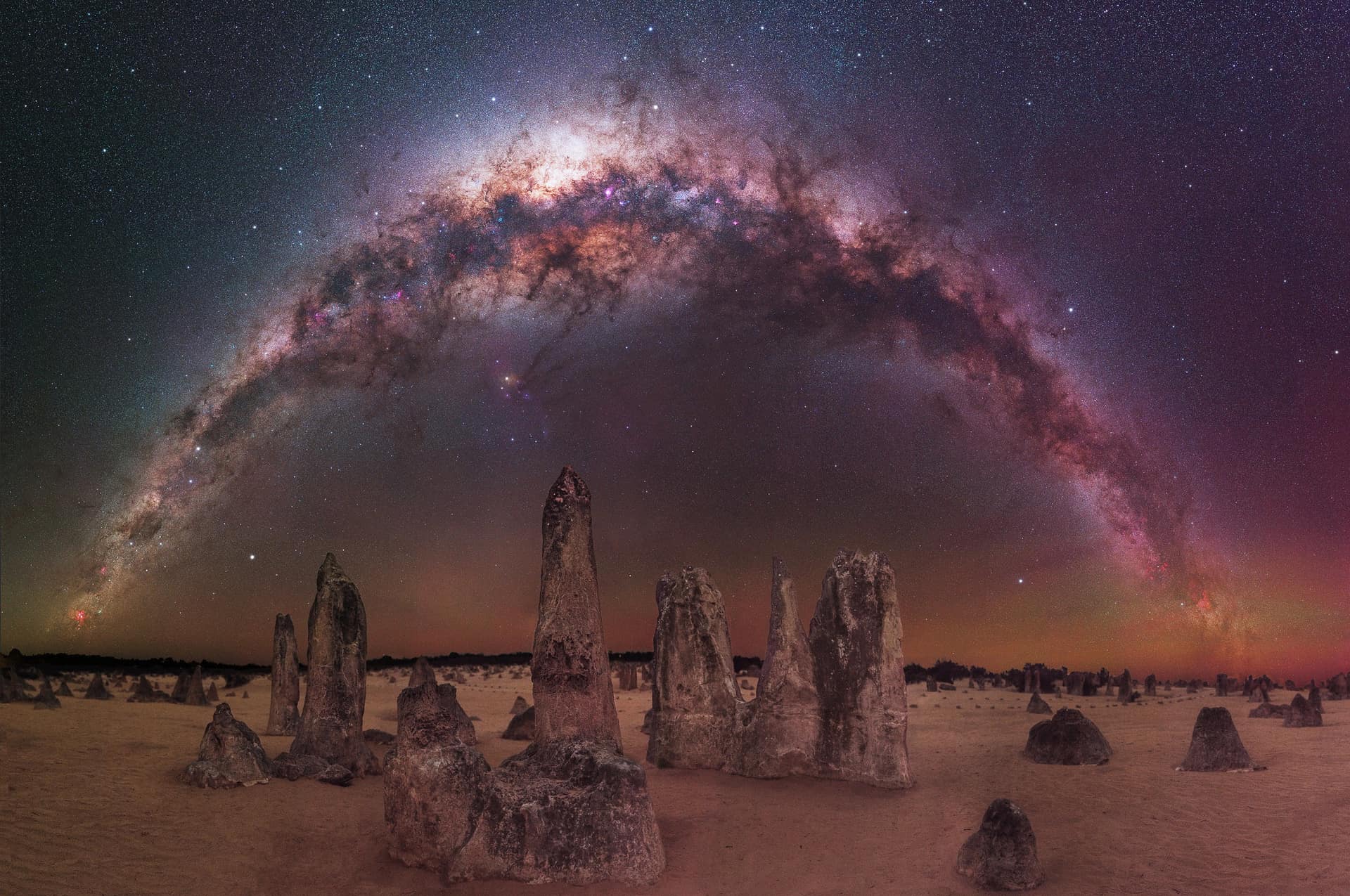
“The Milky Way arching over The Pinnacles Desert” – Trevor Dobson
- Nambung National Park, Australia
This is a 180-degree panorama of the Milky Way as it begins to set towards the western horizon at The Pinnacles Desert, two hours north of Perth in Western Australia.
Using a fast prime lens with a longer focal length allows me to capture the night sky with great detail and vibrancy, but in order to capture the same field of view as a wider-angle lens, it requires so many more shots. For this image, I took 124 individual shots!
The Pinnacles are such an amazing location for astrophotography. The area is littered with thousands of these limestone monoliths, which means that composition possibilities are almost endless and one of the reasons I keep coming back here year after year. It’s such a popular spot that I am almost always in the company of other astrophotographers whenever I visit.
Foreground: ISO 4000, f/2.8, 30 sec. (44 images)
Sky: ISO 4000, f/2.8, 30 sec. (80 images, tracked)
“House of Lavender” – Benjamin Barakat

“House of Lavender” – Benjamin Barakat
- Valensole, France
I captured this image of the Milky Way last summer in Valensole, France. The smell and atmosphere of these lavender fields are unreal, and standing there among them in the middle of the night is blissful, especially since the bees have gone to sleep and you don’t risk getting stung!
Nothing is better than a warm summer night with a beautiful view of the night sky and this lonely, iconic house that sits in the middle of the lavender plateau!
Foreground: ISO 1600, f/5.6, 15 sec. (Captured in the twilight)
Sky: ISO 1600, f/2.0, 30 sec. (4 images)
“The salt road” – Alexis Trigo
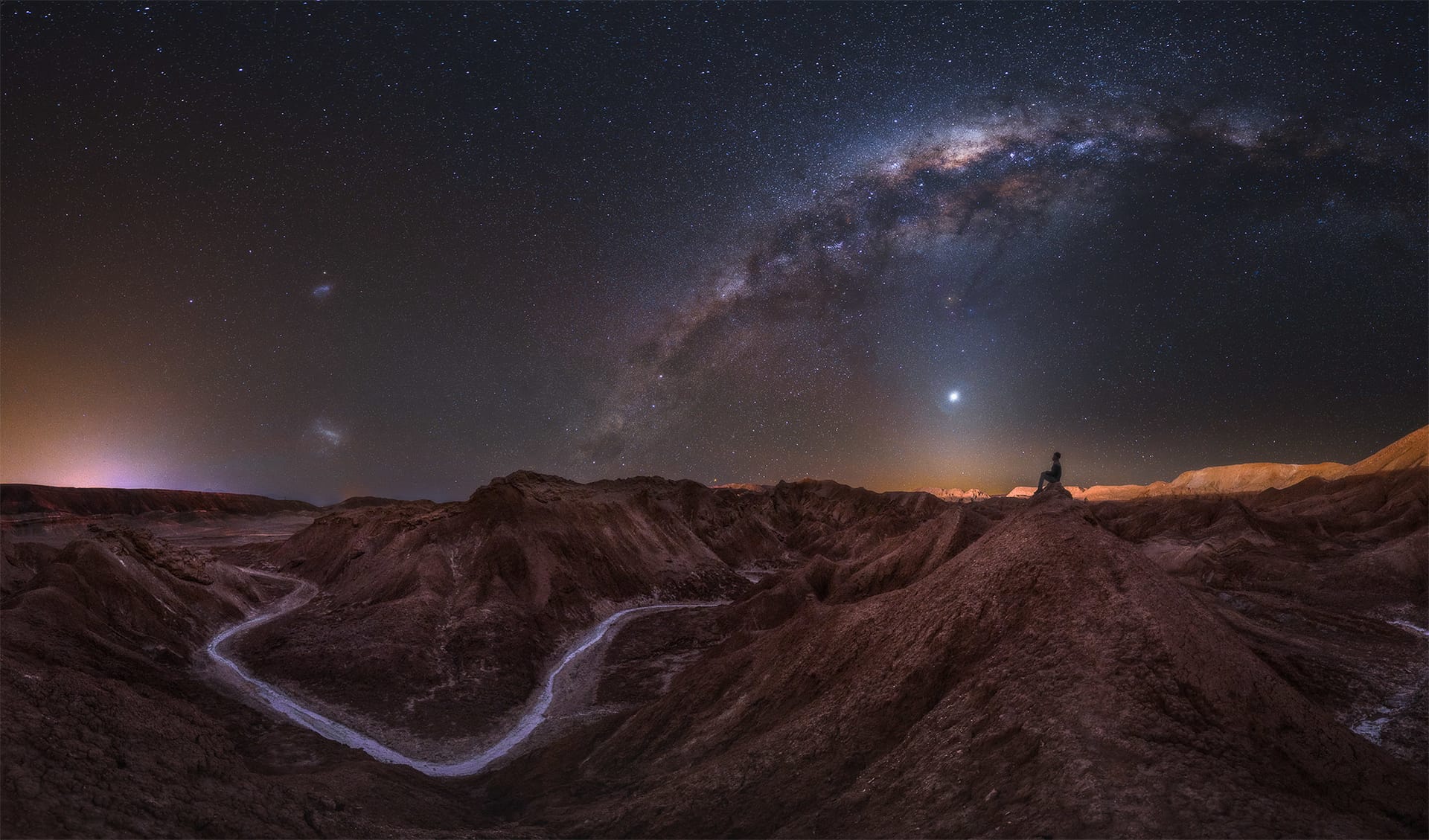
“The salt road” – Alexis Trigo
- San Pedro de Atacama, Chile
When you visit the Atacama Desert, with its arid formations and starry sky, you feel like you’re on another planet.
This place is the millenary salt mountain range where an unbreakable silence reigns, which is ideal for introspection and contemplating the sky. One of my favorite features of this place is the ground’s extensive layer of salt that reflects and enhances the scarce light, which comes mainly from zodiacal light and translates into less noise in the photograph. I discovered this corner one afternoon while I was on a bicycle looking for a unique panoramic view, and I’m so glad I found it!
ISO 4000, f/2.8, 20 sec. (10-photo panorama)
“Path to the past” – Jose Manuel Galvan Rangel

“Path to the past” – Jose Manuel Galvan Rangel
- Extremadura, Spain
“A natural paradise” – that’s the best way to describe the Spanish region of Extremadura.
Not only are the flora and fauna of this lesser-known region spectacular, but so are the night skies, which are full of millions of stars that seem to light up when night falls and are free of pollution and parasitic lights from large cities. Given the quality of the skies in Extremadura, there are numerous Starlight Reserves that can be enjoyed in these uninhabited lands, with many astrophotographers traveling here as their favorite destination.
I took this photograph in a remote town in the southwest part of this community called “Salvatierra de los Barros.” In this town that’s practically unheard of by the rest of the world, you’ll find an imposing, privately owned castle that has been standing, under the light of millions of stars, since the fifteenth century.
Foreground: 20mm, ISO 1600, f3.5, 20 sec.
Sky: 20mm, ISO 2500, f/2, 100 sec.
- Sony A7II Astromod
- Sony FE 20mm G
“Galactic Kiwi” – Evan McKay
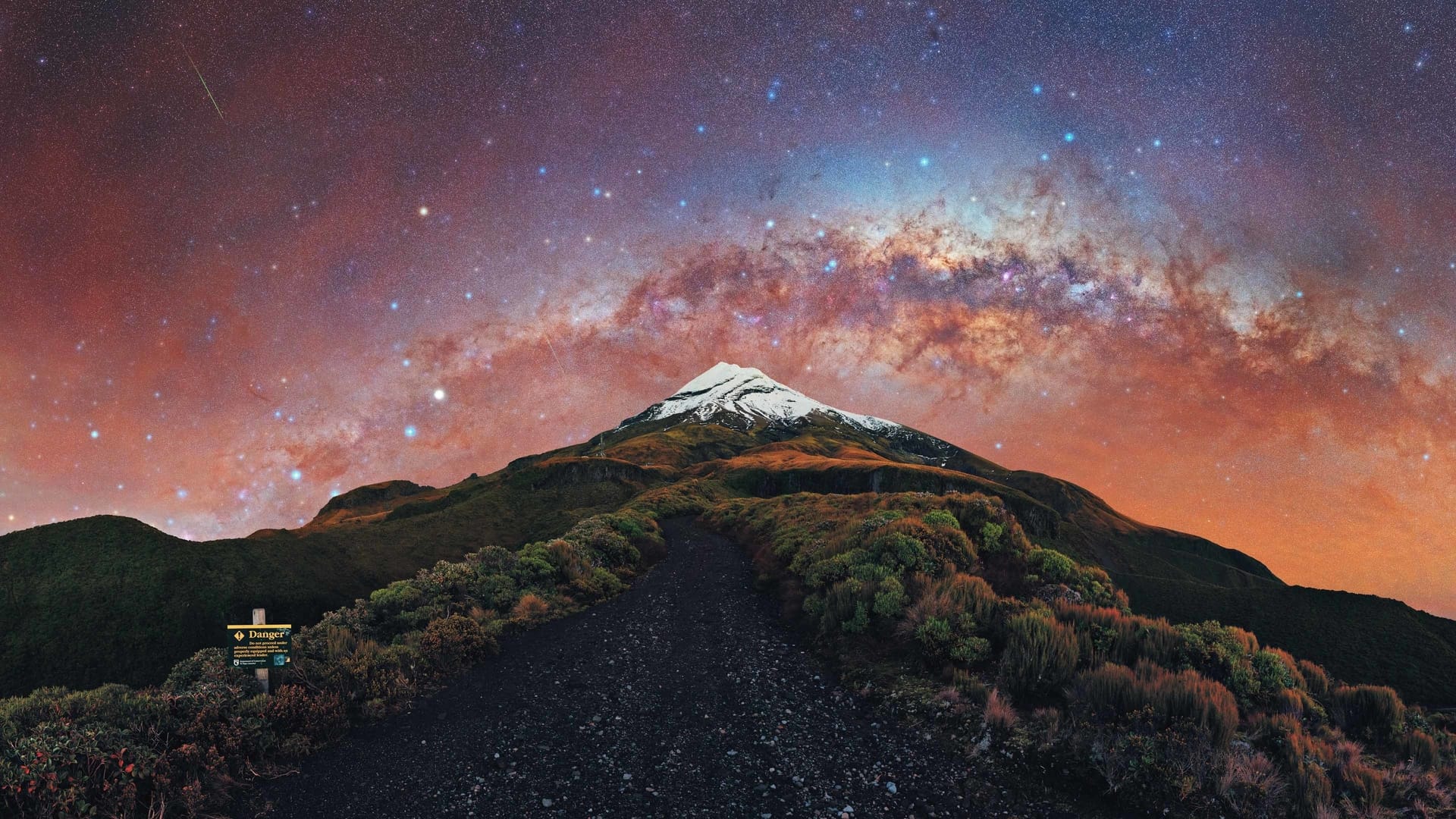
“Galactic Kiwi” – Evan McKay
- Mount Taranaki, New Zealand
Mount Taranaki under the arch of the setting Milky Way. I had shot at this location before but felt I could do better, so I returned on an unexpected trip to give it another go.
I was pleasantly surprised to find the skies had cleared up by the morning and proceeded to hike up and shoot from this spot on The Puffer. While it’s not a perfect alignment with the Milky Way, it was still my first setting arch of the year. There were even a few meteors flying around and I caught some of them on my frames. I arrived a bit late, so the foreground shots ended up being taken during twilight, which required plenty of color, temperature, and exposure adjustments to merge them into a panorama.
Foreground: ISO 1600-3200, f/1.4-1.8, 60-120 sec. (exposure varied based on changing light)
Sky: 11mm, ISO 3200, f/1.8, 8 sec.
“Egyptian Nights” – BURAK ESENBEY
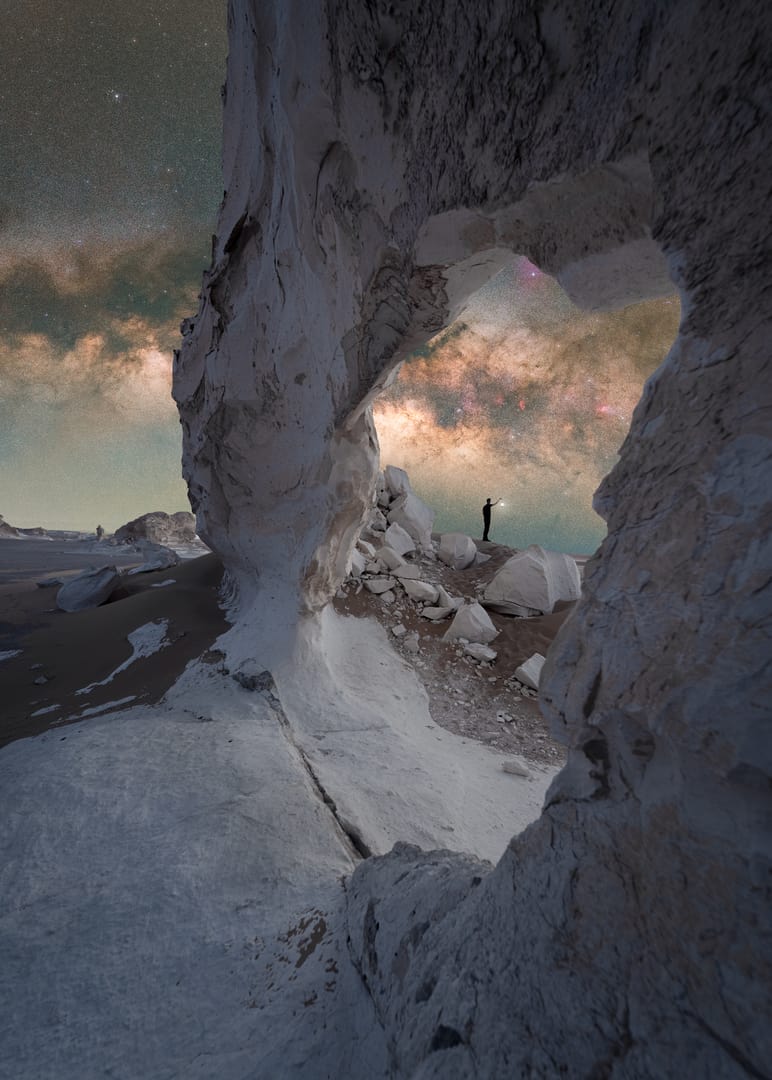
“Egyptian Nights” – Burak Esenbey
- White Desert, Egypt
This year, I went to Egypt for the first time. The white desert was our focus here, in a place full of nature and Bortle 1-2 skies.
From Cairo, we drove about five hours west to our base camp, where we always started our explorations. The desert in Egypt is divided into the White and Black Desert.
As its name suggests, the Black Desert consists of dark soil and large hills, while the White Desert is somewhat rugged but mostly consists of fine, light Saharan sand.
This part is really exciting, because in addition to photogenic sand dunes, there are also a lot of particularly shaped rock formations. Due to the many sandstorms, many of these rock formations are uniquely shaped and thus offer a wide variety of compositions. You will easily believe me when I say that it was really fun to be here.
We did our best to scout and shoot, but, considering the size of the desert, there is still a whole lot more to be discovered here.
Foreground (blue hour), single exposure: 14 mm, 1.3sec, f/4.5, ISO 100
Sky: 18 mm, 3x 180 sec, f/2.8, ISO 1000
“Perseid meteor shower on Mangart saddle” – Uroš Fink
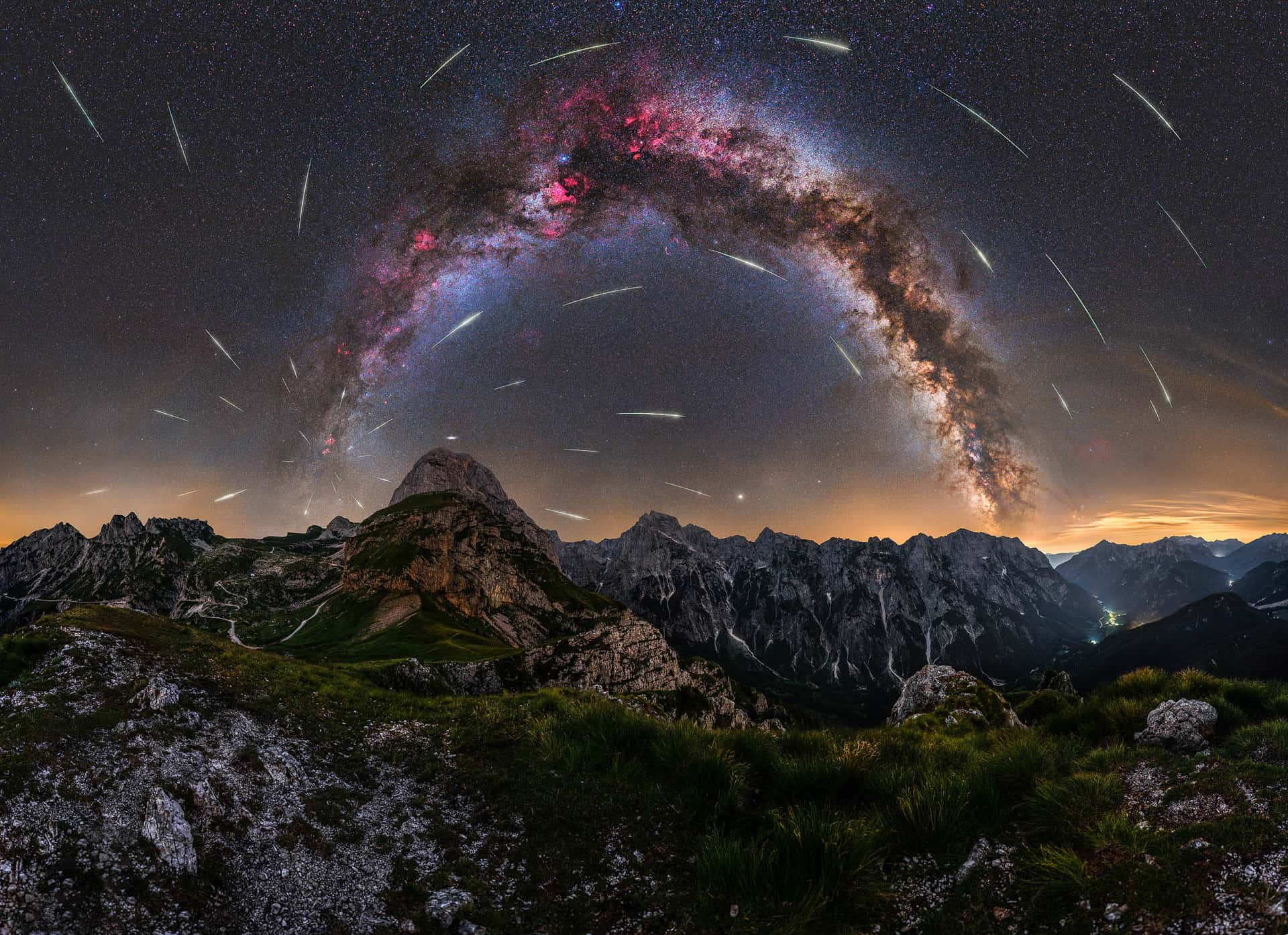
“Perseid meteor shower on Mangart saddle” – Uroš Fink
- Julian Alps, Slovenia
I love nature and being somewhere outside under a starry sky in serene silence. That’s when I feel free, but, at the same time, so small.
What always excites me about photographing the night sky is that you never know what to expect; surprises are happening all over the sky. You just need to be in the right place at the right time. In the end, the experience never disappoints me in any way.
This was one of my most anticipated locations in 2021 that my friend and I planned for 6 months in advance. Of course, that brought us great results. The weather was great at first, but as the night progressed, high clouds appeared, which, unfortunately, obscured what was happening in the sky. However, I caught a few meteors, which brightened up the night. What surprised me while shooting is that, on this night, Mangart Saddle was full of light from all sides and photographers eager for unforgettable moments and photographs.
On the left side of the image is the road that leads to Mangart Saddle. An idyllic location in the middle of the Saddle is the Mangart hut, where you can sleep and eat local cuisine. The highest peak in this part of the Julian Alps is Mangart (2,679 meters), the third highest mountain in Slovenia above which the Andromeda Galaxy emits its light. Slightly to the right of it are Jalovec Mountain and the Loška walls, which rise above the Alpine valley of Loška Koritnica. it was an unforgettable night spent in the great company of friends.
Foreground: ISO 1250, f/2, 90 sec. (2 rows, 16 panels, lower row different focus for focus stacking)
Sky: ISO 61250, f/2.5, 40 sec (3 rows, 16 panels).
“Framing Atacama’s hidden nightscapes” – Cari Letelier

“Framing Atacama’s hidden nightscapes” – Cari Letelier
- San Pedro de Atacama, Chile
As landscape astrophotographers, we dream about finding breathtaking sights under the night skies and projecting our own shadow on a moonless night with the light of the stars, the Milky Way, or the airglow.
We keep planning with maps and weather data to try and encounter that coveted scenario, which is sometimes so difficult to find. Occasionally, though, those perfect compositions just appear in front of you.
This is what happened when I took this picture. As our expedition was ending, this was the last stop, and the unplanned moment with the Milky Way core in the middle of the cave’s frame was just dreamy. However, capturing this image wasn’t easy, since I had to climb up one of the cave’s sides and illuminate the scene very carefully with my headlamp. This was a memorable night with AstroFotografiaChile, Sergio Vindas, and Cima Adventure.
14mm, 10000 ISO, f/1.8, 30 sec. (8-photo panorama)
- Nikon D810A
- Sigma 14mm f/1.8 Art
- Veniwind 324D
- Nodal Ninja
“Milky Way Arch in the morning hours of spring” – Egor Goryachev
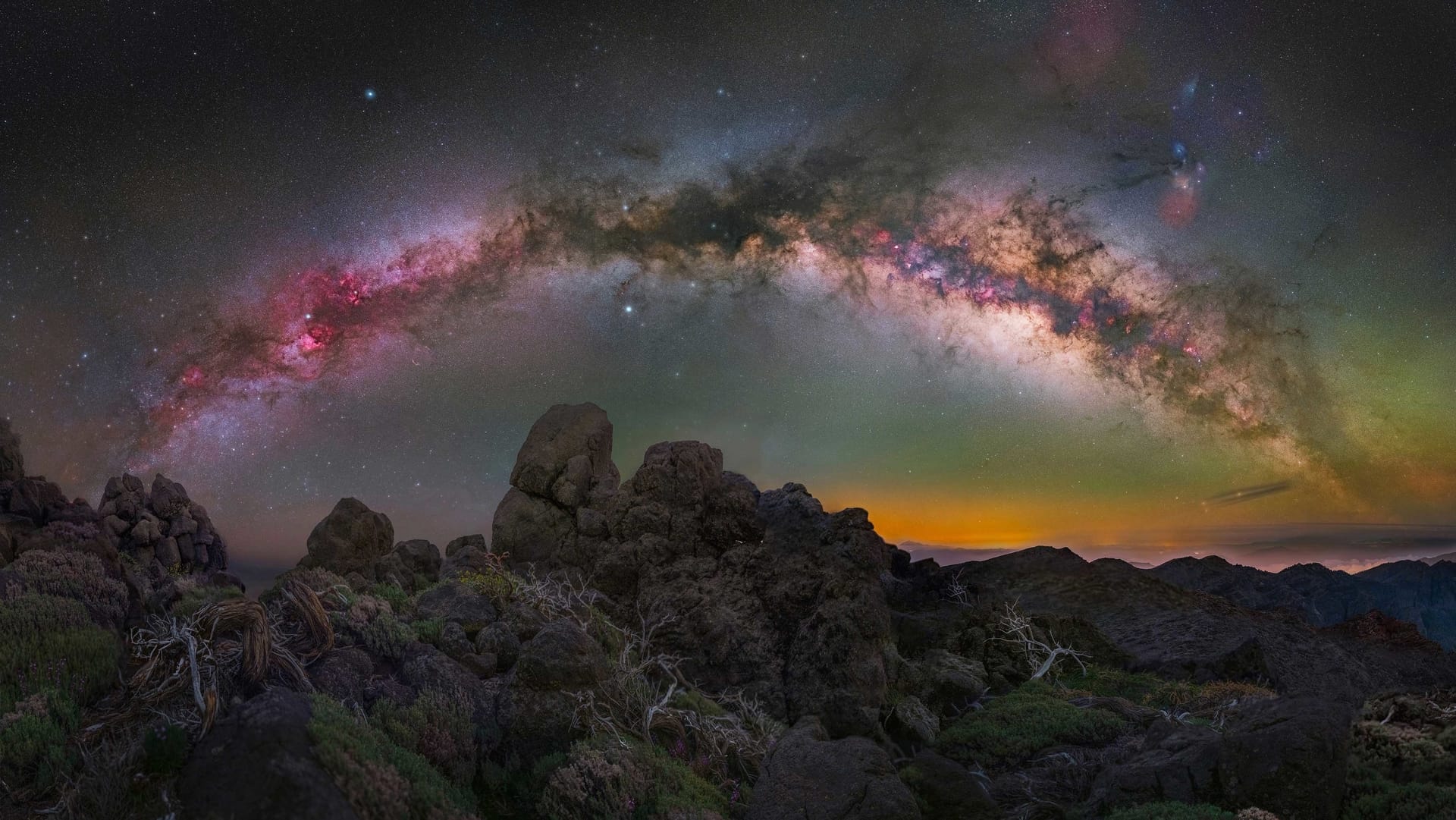
“Milky Way arch in the morning hours of spring” – Egor Goryachev
- La Palma, Canary Islands – Spain
During the spring months, the Milky Way core starts to appear in the southeast part of the early morning sky, so it becomes possible to photograph the whole Milky Way Arch at an almost 180-degree angle from north to south.
I chose Pico de la Cruz, one of the summits on La Palma Island, as my main location to spend the night shooting our galaxy. Around 4 AM, the Milky Way was high enough in the sky that I could start shooting at 50mm and capture a pretty decent arch shape without any distortion of the surrounding stars. Although it was very windy, I was able to photograph some sharp images. All the colors of the Arch, the green airglow emission, the dark sky, and the lights of the neighboring island of Tenerife on the horizon are visible and remind me of this unforgettable experience.
I tried the first night and it was frustrating because the location had zero light pollution, so the photo came out extremely dark, even at ISO 6400. I came back the next day at sunset, and during the blue hour, I took a photo of the foreground. Then, I waited for the Milky Way in the same tripod position and took the photo of the sky.
Foreground: 50mm ISO 800, f/1.4, 1 min.
Sky: 50mm, ISO 6400, f/2.8, 15 sec. (7 images stacked in one shot in Starry Landscape Stacker (noise reduction), 40 shots 50% overlap blended in PS)
- Nikon D750a astro-modified
- Sigma 50 mm F1.4 Nikon Art
- iOptron SkyGuider Pro
“Mt. Fuji and the Milky Way over Lake Kawaguchi” – Takemochi Yuki
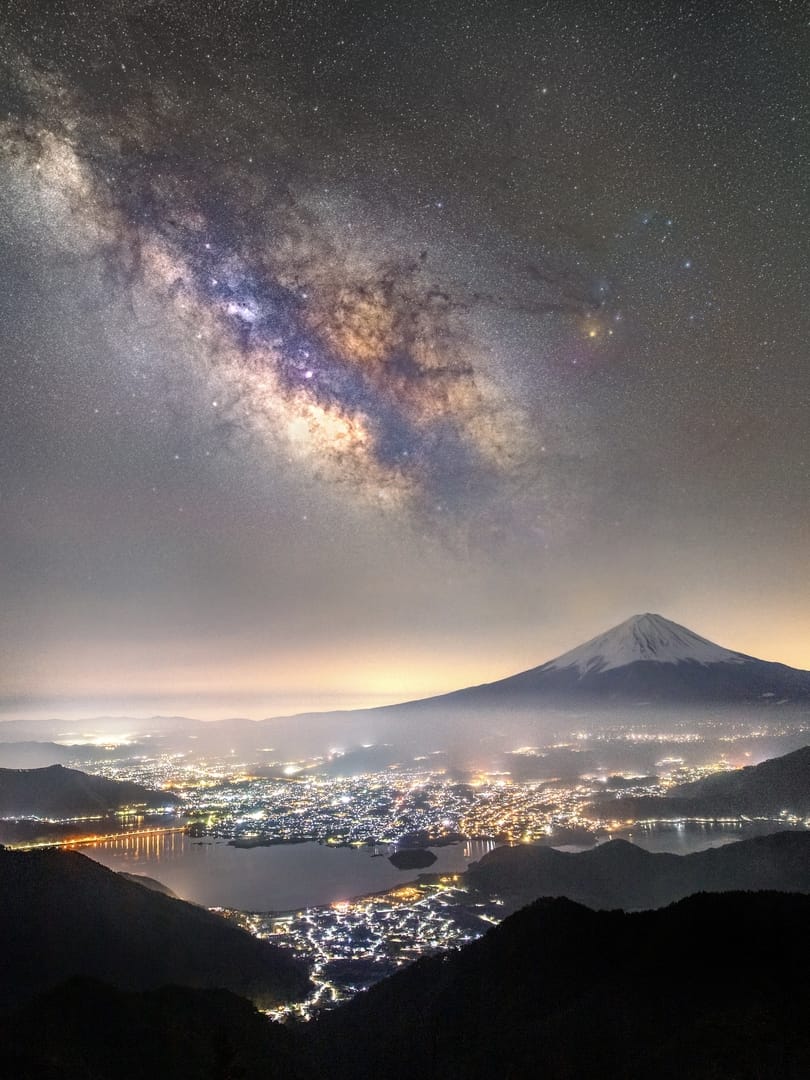
“Mt. Fuji and the Milky Way over Lake Kawaguchi” – Takemochi Yuki
- Yamanashi Prefecture, Japan
This location is called “FUJIYAMA Twin Terrace” and is located in Yamanashi Prefecture, Japan. At night, you can get there by climbing some steps from the parking lot for about an hour. I captured this image on April 9th, 2022, around 3 AM.
This is the only time in spring that you can take a picture of this night view, with Mt. Fuji and the Milky Way. In winter, it becomes difficult to reach the road, since it’s covered in snow. When it gets warmer in the summer, the Milky Way rises to the west and it’s out of frame. I photographed different exposures for the different areas of the scene to balance all the light.
Foreground: 20mm, ISO 10000, f/3.5, 13 sec. (179 photos to reduce noise)
Sky: 20mm, ISO 500-5000, f/3.5, 13 sec. (4 HDR photos)
“Sentinel” – Andy Jones
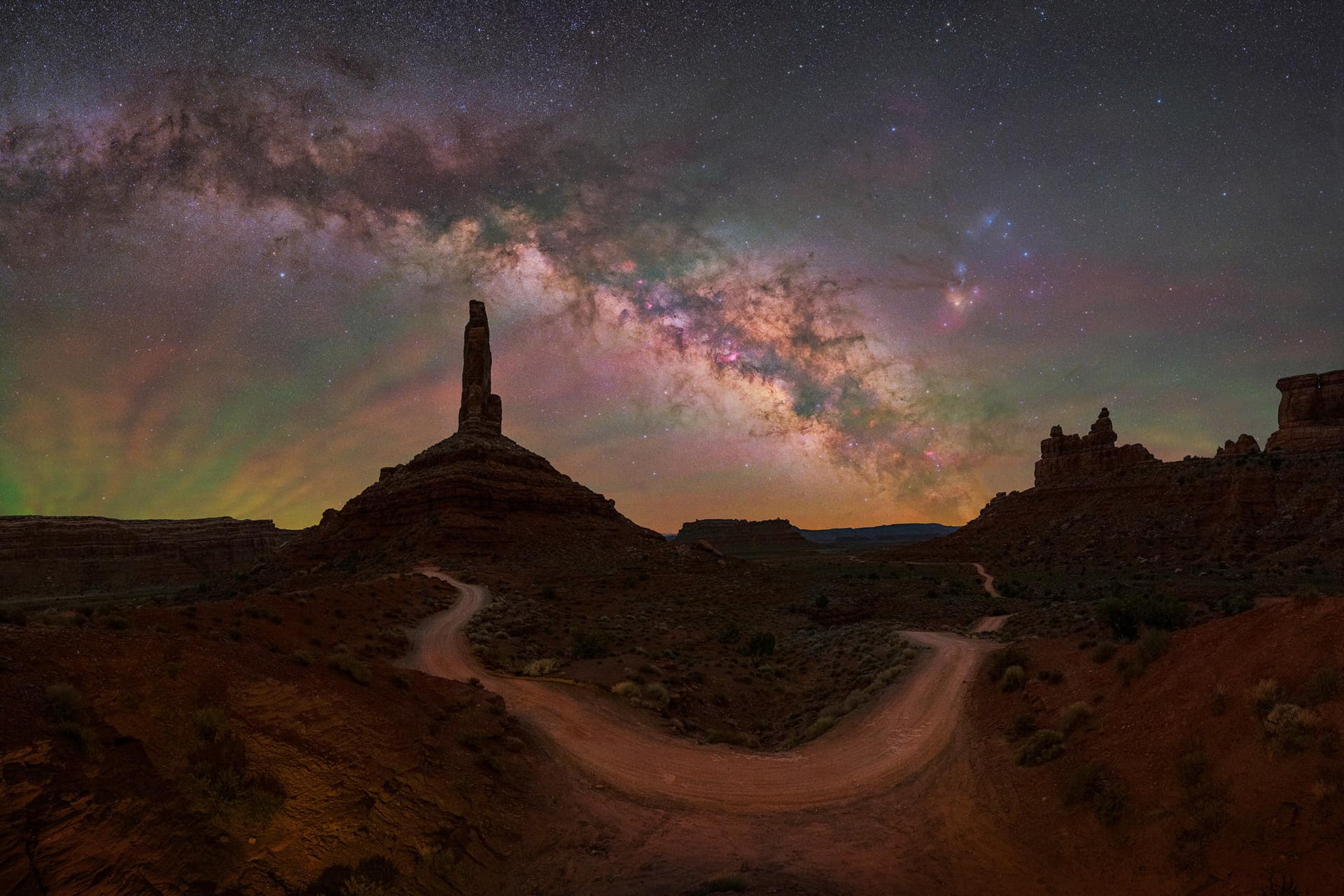
“Sentinel” – Andy Jones
- Utah, USA
Utah is known for its unique desert landscapes, and nature has its own way of drawing your attention.
This sandstone pillar caught mine. It is a large red structure that juts out of the ground and stands watch over the valley, much like a sentinel. It has weathered Mother Nature and battled Father Time. Nevertheless, it’s still standing.
I took a 36-hour getaway to spend a night in this beautiful spot. While the area draws many in for a variety of reasons, I came for the night skies and red rocks. That night did not disappoint. Airglow was on full display with its intense green and orange hues that matched the deep red landscape. The stars were bright and still. The voices and crackle of a small fire from the camp nearby were audible but not loud. All components to an unforgettable memory.
As I shot this panorama, I could not help but think, how many nights, just like this one, has this sandstone sentinel witnessed?
Foreground: ISO 1600, f/2.8, 81 sec. (10 frames – 2×5)
Sky: ISO 1250, f/2.8, 151 sec.
“Stargazing under Central Oregon skies” – Meghann Davis
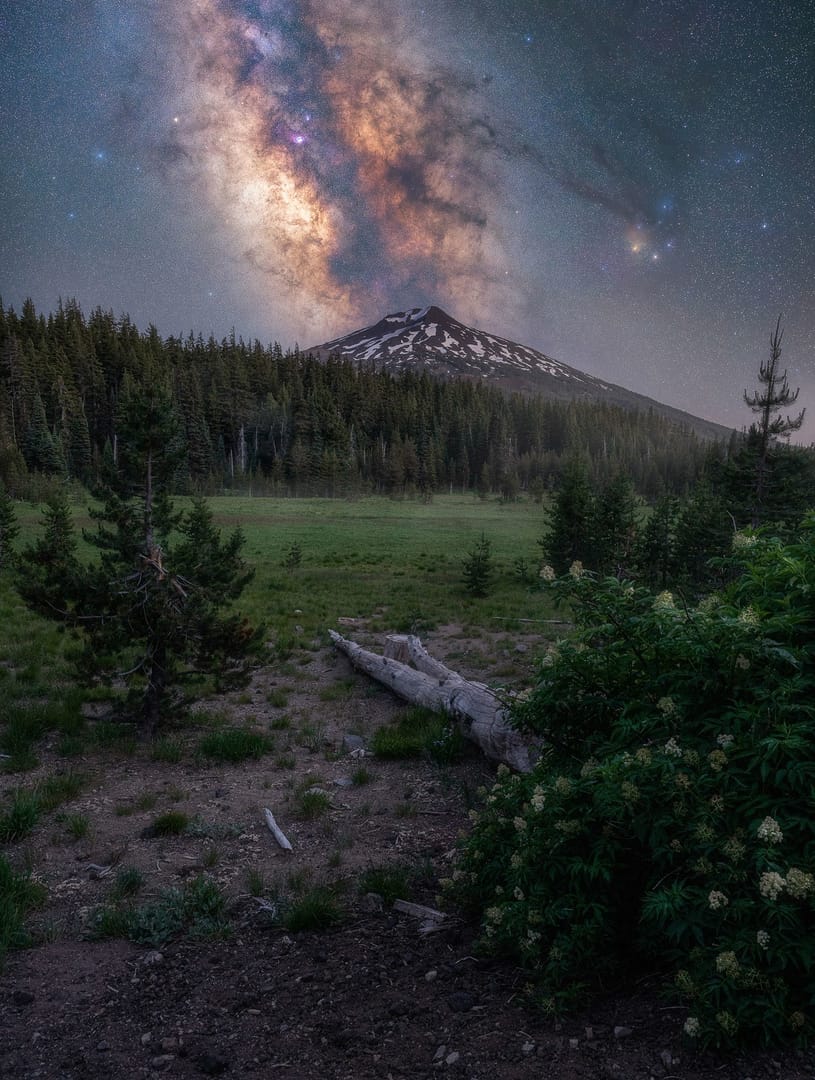
“Stargazing under Central Oregon skies” – Meghann Davis
- Mount Bachelor, Oregon – USA
A night spent under the stars is an incredible experience that everyone should have at least once in their lifetime.
There’s nothing like looking up at the stars and feeling all of your worries melt away. It’s seriously mind-blowing to think that there are some people who have never seen the Milky Way before. If you have yet to do so, grab a cozy blanket, something warm to sip on, bring a friend or two, and get out there!
Foreground: ISO 2500, f/8, 1/4 sec. (Blue hour)
Sky: ISO 1250, f/4, 240 sec (tracked and stacked).
“Erosion at night” – Alberto Enisosbajas Moreno
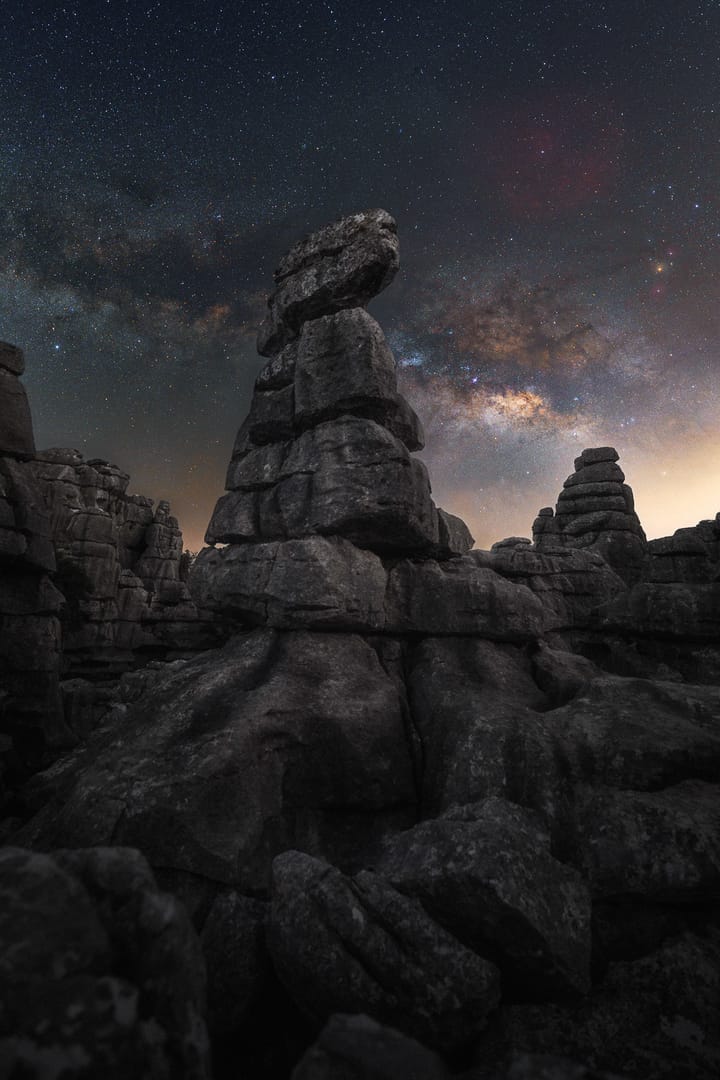
“Erosion at night” – Alberto Enisosbajas Moreno
- Torca del Antequera, Málaga – Spain
The “Torcal de Antequera” is one of the most beautiful natural parks in Spain. It’s a unique landscape that could easily be the setting of a science fiction movie, with plenty of rocks that have been eroded by the passage of time, in an area that was under the sea thousands of years ago.
My favorite thing to do in the park is frame rock formations with our Milky Way Galaxy. To take this photograph, we followed a trail and climbed up some stones to access a steep area called “Arco del Arriero,” where the water and erosion have sculpted a dinosaur-shaped rock formation.
Local photographers call this “the magic of the Torcal,” infinite forms that each person interprets according to their imagination.
Foreground: 16mm ISO 800, f/2.8, 20 sec.
Sky: 16mm, ISO 800, f/2.8, 123 sec.
“Vinchina blue nights” – Gonzalo Javier Santile
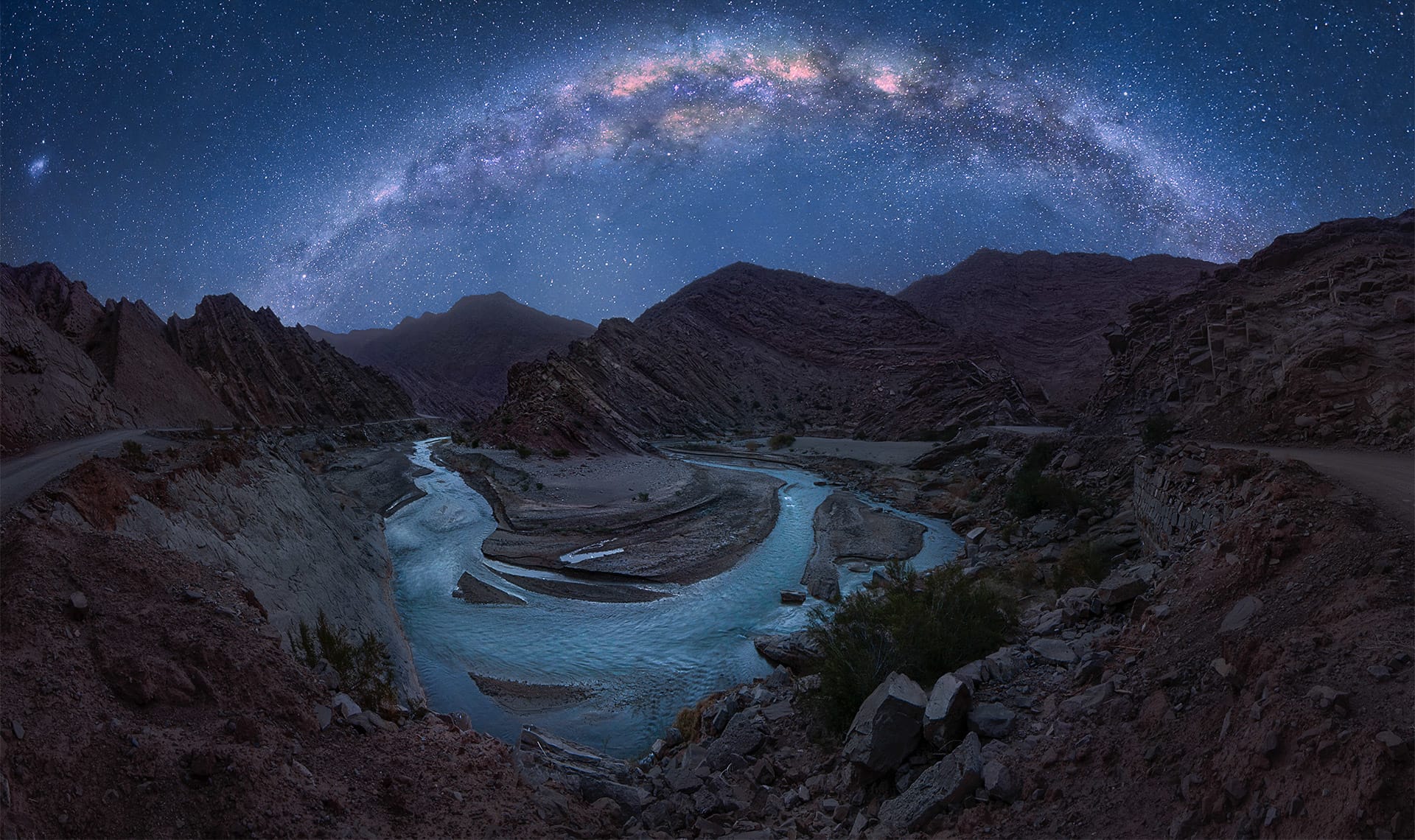
“Vinchina blue nights” – Gonzalo Javier Santile
- La Rioja, Argentina
When I captured this photo, I was staying in the little Argentinian town of Vinchina. I stayed there for 5 days so I could have enough time to explore this natural wonder.
The area known as the “Pyramid” (where this photo was taken) is located just before the climb up a 4,600-meter-high mountain to reach Laguna Brava, where there are geysers and a lagoon full of pink flamingos that arrive during the season year after year. The most spectacular landmark here is the “Corona del Inca” crater, which people sometimes need oxygen to climb.
I tried the first night and it was frustrating because the location had zero light pollution, so the photo came out extremely dark, even at ISO 6400. I came back the next day at sunset, and during the blue hour, I took a photo of the foreground. Then, I waited for the Milky Way in the same tripod position and took the photo of the sky.
Foreground: 9 vertical photos at ISO 100, f/11, 1/3 sec. (Blue hour)
Sky: 11mm, ISO 6400, f/2.8, 20 sec.
“Secrets of the Night” – Daniel Viñé
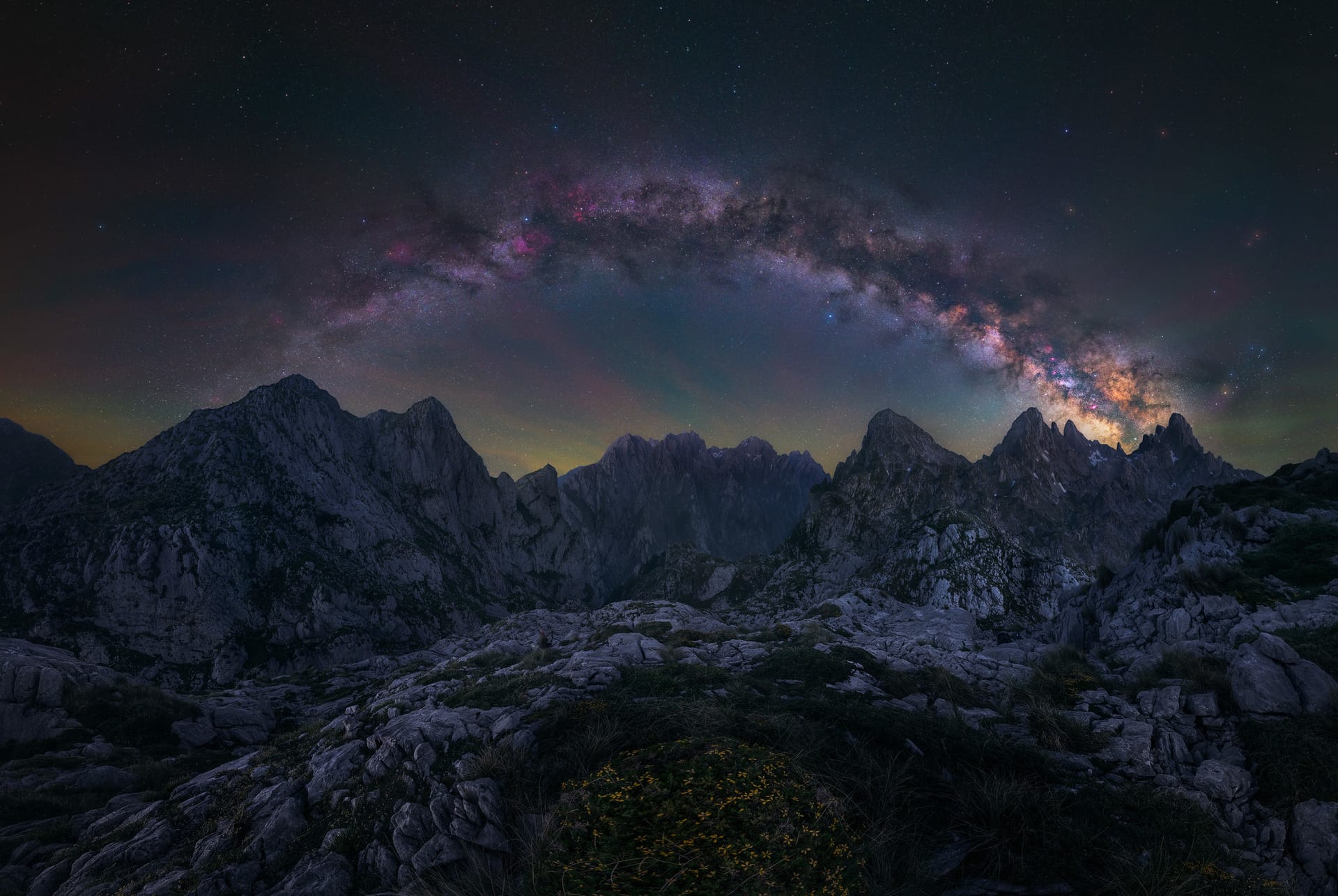
“Secrets of the Night” – Daniel Viñé
- Picos de Europa, Asturias – Spain
I went to this fantastic place in Picos de Europa in Spain with my friend Felipe Souto. To capture this image, we started hiking with all our camera gear, tripods, trackers, and everything we needed to sleep on the mountain.
After several hours of hiking, we were able to set up camp and began exploring the area in search of locations. There was no time to lose, as it was not long before nightfall. The view was epic; we just had to look for a good, powerful foreground. There was a place I loved, which had a small circle of flowers and was surrounded by stones and mountains. If I pointed my camera southwards, the Milky Way would appear on the north face of the “Picos de Europa.”
I took a panorama at the end of blue hour to get the maximum amount of detail in the foreground. Later at night, I used the tracker and my astro-modified camera to photograph another panorama of 7 photographs for the sky.
Foreground: 12mm, ISO 640, f/13, 10 sec. (9-photo panorama)
Sky: 20mm, ISO 640, f/2.8, 180 sec. (9-photo panorama)
I hope you found these images inspiring and that they encourage you to go out and have incredible adventures shooting our galaxy.
If you’re interested in shooting the Milky Way, planning is key, and the best way to prepare your shootings is by downloading our free Milky Way Calendars, which help you figure out the best days and times to capture the galaxy according to your location.
GET THE CALENDAR WITH THE BEST DATES TO PHOTOGRAPH THE MILKY WAY IN 2025
You’ll also receive our PDF guide to photographing the Milky Way!
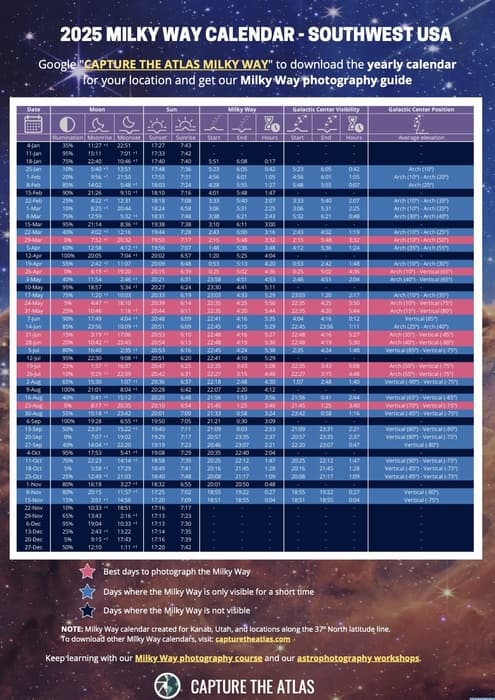
Many of the images on this year’s list were taken using some of the best star trackers. If you want to explore some advanced Milky Way photography, we recommend checking our star-tracker photography guide.
Also, don’t forget that camera gear for shooting the Milky Way and the best settings in Milky Way photography are important.
Thank you for sharing this article with others who might find it inspiring.
Below is the gallery with all the images at their full size. Enjoy it!
Please do not download, copy or share any of the photos here without the author’s prior written permission. Consider the photos here to be protected by copyright. If anyone uses any of the photographs we will take the required legal actions.






